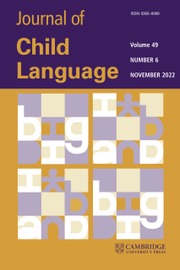Article contents
Gesturing with an injured brain: How gesture helps children with early brain injury learn linguistic constructions*
Published online by Cambridge University Press: 05 December 2012
Abstract
Children with pre/perinatal unilateral brain lesions (PL) show remarkable plasticity for language development. Is this plasticity characterized by the same developmental trajectory that characterizes typically developing (TD) children, with gesture leading the way into speech? We explored this question, comparing eleven children with PL – matched to thirty TD children on expressive vocabulary – in the second year of life. Children with PL showed similarities to TD children for simple but not complex sentence types. Children with PL produced simple sentences across gesture and speech several months before producing them entirely in speech, exhibiting parallel delays in both gesture + speech and speech-alone. However, unlike TD children, children with PL produced complex sentence types first in speech-alone. Overall, the gesture–speech system appears to be a robust feature of language learning for simple – but not complex – sentence constructions, acting as a harbinger of change in language development even when that language is developing in an injured brain.
Information
- Type
- Articles
- Information
- Journal of Child Language , Volume 40 , Special Issue 1: Atypical development , January 2013 , pp. 69 - 105
- Copyright
- Copyright © Cambridge University Press 2012
Footnotes
We thank Kristi Schonwald and Jason Voigt for administrative and technical support, and the project research assistants for their help in data collection and transcription. We also thank the editors, Edith Bavin and Letitia Naigles, and two anonymous reviewers for their helpful comments on an earlier draft. The research was supported by a grant from the National Institute of Child Health and Human Development (P01 HD40605) to Goldin-Meadow and Levine.
References
REFERENCES
- 16
- Cited by

